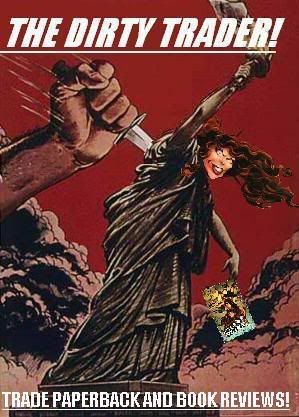
I can't remember the name "Danger Club." I'm sure a fair amount of thought went into the perfect way to evoke juvenile heroic teams of past generations, but the adverse effect is that it's too generic to embed in my memory. I keep wanting to call it "Brat Pack," and that's the problem, isn't it? I'm not particularly fond of Alan Moore, but I recognize that his influence and innovations still resound decades after initial impact. Then along comes Geoff Johns, who simply processes Moore's work through the sensibilities of his equally strong Marv Wolfman influence to create thoroughly mainstream derivative drivel and reap massive rewards as a result. I care even less for Rick Veitch than I do for Moore, and the soil of his creative legacy doesn't appear as lucratively fertile, but he still deserves a co-creator credit for this enterprise by virtue of its so blatantly being the fruit of his past imaginings. Marv Wolfman could probably take a piece as well, but he'd have to give most of it to Chris Claremont, if we followed this train of logic.
Alan Moore's Supreme comics opened with a retro splash page meant to offer the promise of a Silver Age novelty story, then spun it into a modern narrative with a punky swagger. Danger Club is so faithful to the technique that you'd be forgiven for thinking it an honorary member of the recent (and sadly failing) alt-comic revival of Rob Liefeld's Extreme properties. The line-up of Danger Club isn't as doggedly analogous as would be necessary to properly Rob, however. There's a sort of Kid Nick Fury, a young Black Zatara, and a Thor-Boy that mingles Ozymandias into its Loki. My favorite twist is a tiny girl who drives a "giant" robot not too much larger than Iron Man and named after a Flaming Lips concept album. The originality is undone by the lead character though, who is not only plainly Dick Grayson, but seems intended on recalling The Protector, a Robin stand-in created for an '80s anti-drug comic when the Boy Wonder was rendered unavailable due to a licensing conflict. That's pretty goddamn specific.
The premise of the series is Lord of the Flies writ large. All of the adult heroes fly off to take part in one of those epic universe-shaking crossover events, but never come back. Their unsupervised wards then descend into savage in-fighting, forcing Robin and his Teen Titans to go all Damian Wayne on their asses. The first issue is Batman's climactic battle with Superman in The Dark Knight Returns, played with the subtlety of kryptonite brass knuckles. When even the name publishers are riffing on Battle Royale, there's no shock value in this sort of thing anymore. From there, the teen heroes begin a multi-part battle against Doctor Blasphemy, including an ill-considered flash forward that appears to show an awful lot of hand. I say appears because the succeeding issues close out a loop started by the aforementioned prophesy, but offers no real resolution to multiple subplots left as cliffhangers in a series that hasn't published an issue since October. Another legacy of the '80s creator owned vanguard I hope the title doesn't repeat is the eternally unfinished story.
Despite it committing many sins of modern age comics, I do actually want to read more. Landry Q. Walker and Eric Jones have spent the past several years working on DC's all ages titles, and this effort appears to have been given birth out of their frustrations with the restrictions of that format. Rather than thoroughly explaining gentle single issue stories for children, Danger Club is one layer of ongoing mystery cryptically laid on top of another with a definite aversion to exposition. There's a density to the artwork, both in image and in storytelling, that exposes a desire to do more with the medium than Disney Adventures Comic Zone would ever allow. The characters are drawn as realistic adolescents, part of the target demographic of the creators' work-for-hire paychecks, so the visceral quality to the violence perpetrated against them is stomach churning in a way that denies guilt free indulgence. Bratpack was fueled by a clear hatred of the genre, where Danger Club is by professionals who seem to think the New Mutants stories never rose to the challenge of the gauntlet thrown down by Bill Sienkiewicz having drawn them. There's enthusiasm and a level of overall craft on display here (Rusty Drake's coloring is as good as anything else in the book) that at the very least I can't deny Danger Club's superiority in the current market, even as it dilutes the arsenic works with which past creators tried to poison the genre to its death. Galling and totally dependent on familiarity with decades of other people's books though it may be, if a person is going to read transgressive super-hero comics (and these creators have previously produced the positively niche selection of those that are not these days,) Danger Club is one of the best possible options with which to avail oneself.



No comments:
Post a Comment